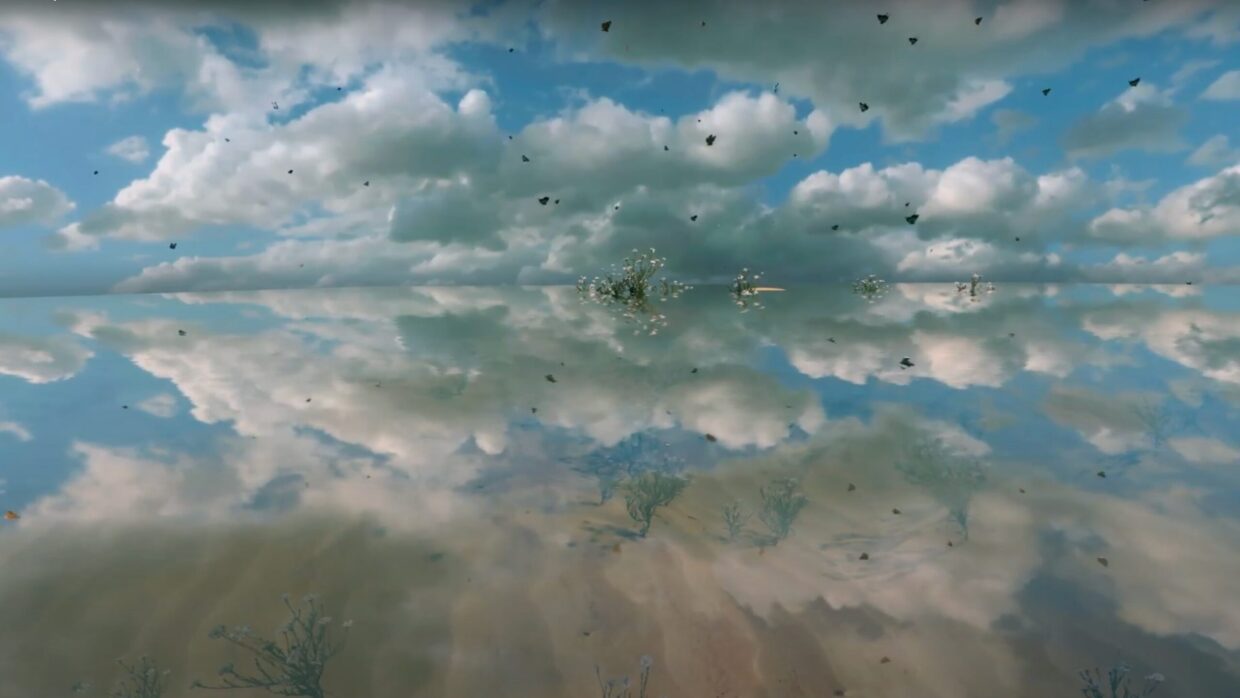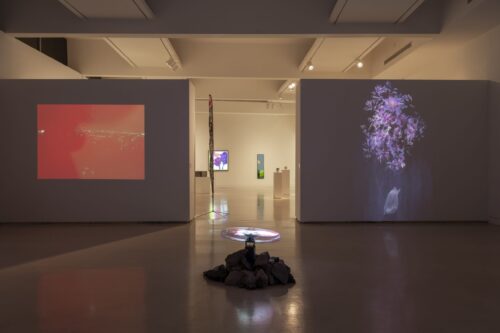 Back to selection
Back to selection
The Intersection of IRL and the Digital: In Media Res: Expanded at the Torrance Art Museum
 New Landscapes 2023, Petra Cortright
New Landscapes 2023, Petra Cortright I’m peering into a small pool of water held in a shallow, roughhewn clay bowl suspended from a bar held aloft by two ladders, and I see moving images of a child’s face, hands, a woman, flowers, the blue of cyanotype, a strawberry. And then a drop of water disrupts the image with a sudden wave of concentric circles, and I am brought out of the image to the water’s surface, to a second layer of experience, realizing in a kind of minor epiphany all the effort I’m expending to see one thing while ignoring all the rest. Looking again, I see the muddy interior of the bowl, the red parachute cord holding it at chest-level, and, glancing up, the seemingly ancient vessel oozing the water that drops periodically to shatter the image below.
These relays of looking are provoked by Katia M. Stewart’s sculptural new media installation titled Aliso Canyon, and they name an organizing theme in the show overall, which is titled In Medias Res: Expanded on view October 12 – December 7, 2024, at the Torrance Art Museum in Southern California. The exhibition follows a previous show organized in August of 2023, when Kate Parsons and Janna Avner of FEMMEBIT presented In Medias Res: Cyber Wave Feminism: A Love Letter to Los Angeles’ Coastal Chapparal with Feral File, the online showcase of digital art founded in 2020 by Casey Reas. That exhibition, with its feminist curatorial perspective, exemplified FEMMEBIT’s dedication to creating a platform to showcase femme and non-binary LA-based artists working in video and new media.

For the TAM’s current expanded exhibition, Parsons and Avner team up again as curatorial partners to present a show in collaboration with the arts collective Supercollider that is at once wry and exuberant featuring 17 artists across two of the museum’s large gallery spaces. In piece after piece, the ease of the contemplative glance is cheerfully thwarted or even uncomfortably perturbed to craft a commentary on the very idea of the visual at this moment in time. We’re invited to survey a full spectrum of technologies, moving from the analog to the digital but from a POV that’s now rooted in the computational, not with the “oh wow” enthusiasm over either form or platform but an insistence on reading the space between surface and depth.
Here’s another example: in Sarah Zucker’s Strabismus Glaciacortex, an old Sony monitor rests sideways on a pillar playing a video that presents a kind of magic eye pattern as pastel pinks, blues, and purples pulse and throb, drawing you toward a decidedly vaginal vortex. You want to stare, but it hurts!
Looking down and to the right, Jennifer West’s P22 on Film Holofan offers a view of the mountain lion known as P22 presented in a flurry of 35mm imagery on top of which she’s added marks of color; the footage was then transferred to digital and presented on two holofans each set atop piles of rocks; the fans use spinning blades to create holographic projections. Once again, the desire to look is thwarted: the spinning fans create an uncomfortable flicker, and the bulky collar circling the beautiful cat’s neck prohibits any naïve projection regarding the wonder of nature.
Beyond West’s work sits Jennifer Juniper Stratford’s Television Figures, which consists of a six-sided pillar that, again, invites the viewer to step up close and peer downward to see heavily processed images of women whose faces and bodies have been distorted with various analog video synthesizers. The colorful retro imagery is in turn refracted by the pillar’s mirrored interior creating a kaleidoscope of deliciously analog video figures bouncing and splintering, a mess of analog glitchiness that frustrates any attempt to see bodies clearly, offering instead blurred trails of ’70s TV colors.
Both Petra Cortright and Eli Joteva offer up flowers conjured through software in their respective pieces. Joteva’s Numinous Cloud: Azaleas presents gorgeous pink flowers that undulate as if under water while bits of white dust or snow rain downward to be caught in part by a disembodied hand. The piece’s very large scale, gentle movement, and glistening illumination from above evoke a sense of the mysterious and spiritual and invite a moment of repose, while the dissolution core to the piece reminds us of inherent decay.
Cortright ruptures Joteva’s contemplative vibe with an anxious camera that prowls impatiently across a digital landscape in a series of three videos (named numerically as 1.mp4; 26.mp4; and 33.mp4). We track quickly through the grasses and rocks at ground level, then zoom up only to drop down, moving quickly with a series of jerks. At certain points, the layers disassemble; rocks hover above the ground. Then we dive straight through, ending up below the land mass, a flying perspective absent a body. Did I mention that all this frenetic camerawork is thrilling, even beautiful? I could watch it for hours! However, again, I do not watch with a sense of traditional aesthetic pleasure but instead with a rapt feeling of yes, this is what it’s like to be human in our world right now.
Many of the projects in In Medias Res: Expanded feature landscapes, and the show’s broader gambit points to relations and embeddedness; we exist within complex networks of interconnection, many of these being the intersection of IRL and the digital. But more broadly, the pieces center the ongoingness of the feminist impulse. The works continue – and honor – a longer history of work intended to query, disrupt, suspend, glitch, and reimagine the norms – especially those of gender – that so badly govern our world and limit its potentials. Finally, returning to the experience of Stewart’s Aliso Canyon, the show asks what, as we look around, do we choose not to see?
